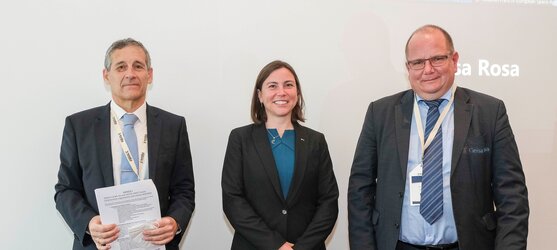ESA’s 5G/6G Hub used to simulate lunar connection
Engineers have used ESA’s next-generation communications research facility to simulate links between Earth and the Moon via satellites.
As the world becomes ever more digitalised and connected – between everything and everyone – such connectivity is poised to transform life on Earth and beyond.
Next-generation 5G and 6G technology will provide fast and high-volume data connectivity to fuel this transformation – and telecommunications satellites will play a crucial role in enabling the seamless and ubiquitous connectivity on which 5G and 6G networks rely.
Interoperability between terrestrial 5G communications links and telecommunications satellites is crucial to ensure that everything and everyone stays connected wherever they go.

Engineers recently conducted a series of tests to demonstrate how to switch between 5G terrestrial links and satellites.
Researchers from the University of Luxembourg’s Interdisciplinary Centre for Security, Reliability and Trust (SnT) initially established an end-to-end 5G data communications link between their 5G-SpaceLab and ESA’s 5G/6G Hub located at Harwell in the UK.
In the first test, the engineers connected commercial 5G standard-compliant smartphones to the 5G radio access networks at both ends and verified the terrestrial connection between them.
Then ESA’s end of the connection was rerouted via satellite to demonstrate the interoperability of the terrestrial and satellite systems.
Finally the university’s end of the connection was passed through a lunar communications channel emulator, developed by researchers to mimic the communications delays experienced by a data trunk link between Earth and the Moon. Using the set up, engineers attempted to steer a rover trundling across the lunar surface. The accumulated latency over the terrestrial, satellite and emulated lunar communications infrastructure caused a round-trip delay of three to four seconds between the issuing of the rover instruction and the rover’s response.
Jorge Querol, who coordinates the 5G-SpaceLab at the University of Luxembourg, said: “5G and 6G are playing a key role in the development of future complex communications systems in space. Future lunar activities such as resource exploitation and human settlements will require such communications systems for their safe, reliable and efficient operation. The purpose of connecting both labs was to successfully demonstrate lab federation and technology interoperability. Using the ESA 5G/6G Hub enabled us to combine real-time over-the-satellite transmission to our lunar communications emulation facility.”
Antonio Franchi, Head of ESA's 5G/6G Strategic Programme, said: “5G and 6G technology is predicted to generate staggering benefits for economies worldwide over the next decade, including autonomous vehicles, industrial automation and telehealth. Telecommunications satellites will play a crucial role in enabling the ubiquitous connectivity on which 5G and 6G networks rely. Our demonstration of the seamless switching between a terrestrial network and a space-enabled network shows the great promise of this technology.”
Elodie Viau, Director of Telecommunications and Integrated Applications at ESA, said: “Next-generation communications technologies are crucial to keeping everyone and everything connected at all times. Europe must continue to invest so that ESA can continue to create jobs and prosperity in Europe by fostering innovation that helps European space companies succeed in competitive global markets. At the same time, ESA seeks to enable the sustainable exploration of space by supporting private space firms in Europe to create a network of telecommunication and navigation satellites around the Moon, in a project called Moonlight. This collaboration is just one example of how ESA is shaping the future.”















 Germany
Germany
 Austria
Austria
 Belgium
Belgium
 Denmark
Denmark
 Spain
Spain
 Estonia
Estonia
 Finland
Finland
 France
France
 Greece
Greece
 Hungary
Hungary
 Ireland
Ireland
 Italy
Italy
 Luxembourg
Luxembourg
 Norway
Norway
 The Netherlands
The Netherlands
 Poland
Poland
 Portugal
Portugal
 Czechia
Czechia
 Romania
Romania
 United Kingdom
United Kingdom
 Slovenia
Slovenia
 Sweden
Sweden
 Switzerland
Switzerland






























